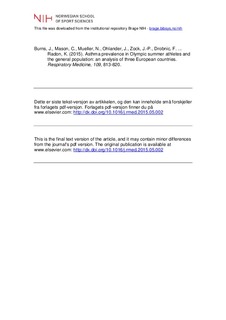| dc.contributor.author | Burns, Jacob | |
| dc.contributor.author | Mason, Catherine | |
| dc.contributor.author | Mueller, Natalie | |
| dc.contributor.author | Ohlander, Johan | |
| dc.contributor.author | Zock, Jan-Paul | |
| dc.contributor.author | Drobnic, Franchek | |
| dc.contributor.author | Wolfarth, Bernd | |
| dc.contributor.author | Heinrich, Joachim | |
| dc.contributor.author | Omenaas, Ernst | |
| dc.contributor.author | Stensrud, Trine | |
| dc.contributor.author | Nowak, Dennis | |
| dc.contributor.author | Radon, Katja | |
| dc.date.accessioned | 2016-08-30T12:26:43Z | |
| dc.date.available | 2016-08-30T12:26:43Z | |
| dc.date.issued | 2015-05-14 | |
| dc.identifier.citation | Respiratory Medicine. 2015, 109, 813-820 | nb_NO |
| dc.identifier.uri | http://hdl.handle.net/11250/2402823 | |
| dc.description | Dette er siste tekst-versjon av artikkelen, og den kan inneholde små forskjeller fra forlagets pdf-versjon. Forlagets pdf-versjon finner du på www.elsevier.com /
This is the final text version of the article, and it may contain minor differences from the journal's pdf version. The original publication is available at www.elsevier.com | nb_NO |
| dc.description.abstract | Background:
Some studies have shown a higher prevalence of asthma in elite athletes as compared to the general population. It is inconclusive to what extent certain sport categories are especially affected. The present study offered a unique opportunity to assess these differences in asthma prevalence in the general population and elite summer athletes from a wide range of sport disciplines across various geographical areas.
Methods:
Cross-sectional data for 1568 general population participants from the European Community Respiratory Health Survey II and 546 elite athletes from the Global Allergy and Asthma European Network Olympic study from three European countries were analyzed. Using logistic regression, the asthma risks associated with athlete sport practice, endurance level and aquatic sport practice, respectively, were investigated.
Results:
Athletes in the highest endurance category had increased risk of doctor-diagnosed asthma (OR 3.5; 95% CI 1.7–7.5), asthma symptoms (OR 3.0; CI 1.5–6.0) and asthma symptoms or medication use (OR 3.5; CI 1.8–6.7) compared to the general population. Aquatic athletes were at increased risk of doctor-diagnosed asthma (OR 2.0; CI 1.1–3.9), asthma symptoms (OR 2.6; CI 1.3–5.0) and asthma symptoms or medication use (OR 2.3; CI 1.2–4.4) when compared to individuals not involved in aquatic sports. Regarding the entire athlete population, no increase in asthma was found when compared to the general population.
Conclusions:
Practice of very high endurance and aquatic sports may be associated with increased asthma risks. Athlete participation as such showed no association with asthma risk. | nb_NO |
| dc.language.iso | eng | nb_NO |
| dc.publisher | Elsevier | nb_NO |
| dc.subject | athletics | nb_NO |
| dc.subject | endurance | nb_NO |
| dc.subject | epidemiology | nb_NO |
| dc.subject | exercise | nb_NO |
| dc.subject | respiratory | nb_NO |
| dc.title | Asthma prevalence in Olympic summer athletes and the general population: An analysis of three European countries | nb_NO |
| dc.type | Journal article | nb_NO |
| dc.type | Peer reviewed | nb_NO |
| dc.subject.nsi | VDP::Medical disciplines: 700 | nb_NO |
| dc.source.journal | Respiratory Medicine | nb_NO |
| dc.identifier.doi | http://dx.doi.org/10.1016/j.rmed.2015.05.002 | |
| dc.description.localcode | Seksjon for idrettsmedisinske fag / Department of Sports Medicine | nb_NO |
